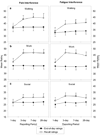Interference with activities due to pain and fatigue: accuracy of ratings across different reporting periods
- PMID: 20535565
- PMCID: PMC2940938
- DOI: 10.1007/s11136-010-9681-x
Interference with activities due to pain and fatigue: accuracy of ratings across different reporting periods
Abstract
Purpose: This study examined the impact of different reporting period lengths on the accuracy of items measuring interference due to pain and fatigue with work, walking, and relations with others.
Methods: Six items from well-established instruments (Brief Pain Inventory, Brief Fatigue Inventory, SF-36) were investigated in a prospective study of 117 patients with chronic rheumatological illness. Daily ratings were compared with recall ratings of 1, 3, 7, and 28-day reporting periods.
Results: The level of recall ratings (RRs) for reporting periods of 3 days or more were significantly higher than the level of aggregated end-of-day (EOD) ratings. Correspondence between aggregated EOD and RRs was good (r ≥ .80) regardless of the length of the reporting period. Ratings of interference for a single day were highly correlated with aggregated EOD for up to 14 days prior to the single rating (r ≥ .76).
Conclusions: Recall ratings with reporting periods of up to a month yield good correspondence with aggregated daily ratings, although the absolute level of the rating will be inflated for recall periods of 3 days or longer.
Figures


Similar articles
-
The accuracy of pain and fatigue items across different reporting periods.Pain. 2008 Sep 30;139(1):146-157. doi: 10.1016/j.pain.2008.03.024. Epub 2008 May 1. Pain. 2008. PMID: 18455312 Free PMC article.
-
Can End-of-day reports replace momentary assessment of pain and fatigue?J Pain. 2009 Mar;10(3):274-81. doi: 10.1016/j.jpain.2008.09.003. Epub 2008 Dec 13. J Pain. 2009. PMID: 19070550 Free PMC article.
-
Validity of average, minimum, and maximum end-of-day recall assessments of pain and fatigue.Contemp Clin Trials. 2010 Sep;31(5):483-90. doi: 10.1016/j.cct.2010.06.004. Epub 2010 Jul 8. Contemp Clin Trials. 2010. PMID: 20620239 Free PMC article.
-
Temporal trends in symptom experience predict the accuracy of recall PROs.J Psychosom Res. 2013 Aug;75(2):160-6. doi: 10.1016/j.jpsychores.2013.06.006. Epub 2013 Jul 6. J Psychosom Res. 2013. PMID: 23915773 Free PMC article.
-
Pittsburgh and Epworth sleep scale items: accuracy of ratings across different reporting periods.Behav Sleep Med. 2013;11(3):173-88. doi: 10.1080/15402002.2012.654549. Epub 2012 Dec 3. Behav Sleep Med. 2013. PMID: 23205491 Free PMC article.
Cited by
-
Impact of recall period on primary brain tumor patient's self-report of symptoms.Neurooncol Pract. 2014 Jun;1(2):55-63. doi: 10.1093/nop/npu006. Epub 2014 May 5. Neurooncol Pract. 2014. PMID: 26034617 Free PMC article.
-
Psychometric characteristics of daily diaries for the Patient-Reported Outcomes Measurement Information System (PROMIS®): a preliminary investigation.Qual Life Res. 2013 Sep;22(7):1859-69. doi: 10.1007/s11136-012-0323-3. Epub 2012 Nov 23. Qual Life Res. 2013. PMID: 23180166 Free PMC article.
-
Comparison of weekly and daily recall of pain as an endpoint in a randomized phase 3 trial of cabozantinib for metastatic castration-resistant prostate cancer.Clin Trials. 2021 Aug;18(4):408-416. doi: 10.1177/17407745211009547. Epub 2021 Apr 22. Clin Trials. 2021. PMID: 33884929 Free PMC article. Clinical Trial.
-
Difference in method of administration did not significantly impact item response: an IRT-based analysis from the Patient-Reported Outcomes Measurement Information System (PROMIS) initiative.Qual Life Res. 2014 Feb;23(1):217-27. doi: 10.1007/s11136-013-0451-4. Epub 2013 Jul 23. Qual Life Res. 2014. PMID: 23877585 Free PMC article. Clinical Trial.
-
Does recall period matter? Comparing PROMIS® physical function with no recall, 24-hr recall, and 7-day recall.Qual Life Res. 2020 Mar;29(3):745-753. doi: 10.1007/s11136-019-02344-0. Epub 2019 Nov 7. Qual Life Res. 2020. PMID: 31701432 Free PMC article.
References
-
- Mendoza TR, Wang XS, Cleeland CS, Morrissey M, Johnson BA, Wendt JK, et al. The rapid assessment of fatigue severity in cancer patients: use of the Brief Fatigue Inventory. Cancer. 1999;85(5):1186–1196. - PubMed
-
- Daut RL, Cleeland CS. The prevalence and severity of pain in cancer. Cancer. 1982;50(9):1913–1918. - PubMed
-
- Aaronson NK, Ahmedzai S, Bergman B, Bullinger M, Cull A, Duez NJ, et al. The European Organization for Research and Treatment of Cancer QLQ-C30: a quality-of-life instrument for use in international clinical trials in oncology. Journal of the National Cancer Institute. 1993;85(5):365–376. - PubMed
-
- Ware JE. SF-36 Health Survey: Manual & Interpretive Guide. Boston: The Health Institute, New England Medical Center; 1993.
-
- Kerns R, Turk D, Rudy T. The West Haven-Yale Multidimensional Pain Inventory (WHYMPI) Pain. 1985;23:345–356. - PubMed
Publication types
MeSH terms
Grants and funding
LinkOut - more resources
Full Text Sources
Medical

